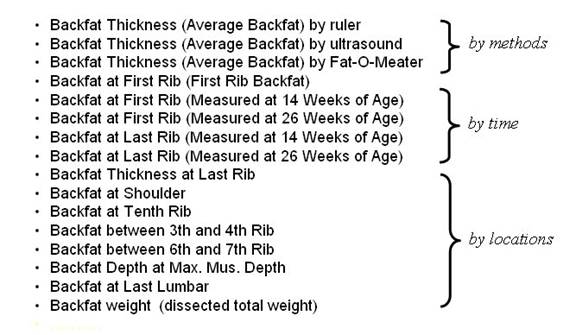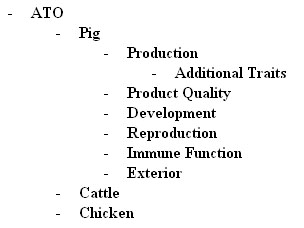Developing Frameworks and Tools for the Livestock Community
An Introduction to ATO
General Description of the Animal Trait Ontology (ATO)
The Animal Trait Ontology (ATO) is a large scale ontology effort that deals with the standardization and centralizing of livestock animal traits. The ATO was created to meet the need for precise management and representation of farm animal traits with the increasing amount of biological and genomic information associated with them. It was imperative that a standard nomenclature be created so that animal science researchers may communicate consistently and unambiguously.The ATO currently contains data from three domesticated farm animal species: Bos taurus (cattle), Gallus gallus (chicken), and Sus scrofa (pig). The original goal of the ATO was to create a medium for the standardization, annotation, retrieval, integration, and analysis of animal trait information, in particular, traits with Quantitative Trait Loci (QTL) associated. However, it has became evident that a standardized trait ontology would be instrumental in forming effective and consistent communications among animal science researchers.
Why do we need an Animal Trait Ontology?
The need for an ATO is evident for several reasons. First, there was no central repository for trait information. Trait information was spread amongst journal articles, books, local researcher archives, and other miscellaneous sources. These disparate sources of phenotypic information further contributed to the inconsistency of trait terms (e.g., daily gain and average daily gain).Secondly, on a global perspective, trait information is sometimes inconsistent between different regions of the world. For instance, in Europe, it is common to see the term "meat colour" used for describing a meat quality trait, but in the United States, "meat color" is used to describe the trait. The ATO will help bridge the gap between nomenclatures in different parts of the world.
Thirdly, by having an animal trait ontology, it is possible to perform computational analysis of the traits using the semantic web which is composed of machine understandable data and knowledge for the automatic discovery, integration, and reuse of those data and knowledge across several applications. The trait information in the ATO, for instance, is expected to be linked to quantitative trait information in the future which will allow inferences to be made by linking different QTL regions to traits. Such a feature will allow comparative phenotype/QTL studies to be performed between species, including humans, rats, and mice. Alternatively, it may be used to link information across disciplines (e.g., nutrition and genetics). The ATO could also be beneficial to animal scientist by interconnecting it with other ontologies. For example, the traits in the ATO could be linked to an anatomy ontology or an ontology which stores genomic information such as the Gene Ontology (GO). It may also be used to improve the searching of electronic publications through the inclusion of all relevant synonyms for a particular trait name.
The importance of the Animal Trait Ontology can be also seen with the following examples. In the first example, the problem of semantics of farm animal traits is illustrated. Semantics involves the meanings of words and, in this case, multiple trait names for the same trait. During the curation of several research journals for the trait name "ribeye area", several alternative forms of the trait were found (e.g., rib eye area, rib muscle area). Each of these trait names shares the same semantics (meanings), but different spellings. It is expected that the need for alternative forms of a trait name will be alleviated once the trait ontology becomes widely used by animal science researchers as the standardization of traits becomes evident. There will still be an issue with historical data, but the continued use of synonyms will aid in the inclusion of such data.
Another issue that the ATO will encounter is the variations in trait information. Variations occur when a phenotype is measured in several different ways. For example, the trait "backfat" is measured in three different measurement types: methods (e.g., ruler, ultrasound), time (e.g., 14 weeks of age), and locations (e.g., shoulder, tenth rib) (Figure 1). With the ATO, such measurement variations will be better contained and understood by researchers. The standardization of trait information variations will further aid in the eradication of ambiguities in trait names.

An example of the variation of trait measurements that can be evident in some traits. In this example, backfat is used to show how the trait is measured according to different methods, times, and locations. Also, within each measurement type, there are different measurement specifications.
Terms: Phenotype vs. Trait
The terms in the ATO includes traits and phenotypes. We define a trait as that which is specifically measured. For example, femur length would be a trait. In contrast, diabetes is a disease, but not a trait. Insulin level or blood glucose level would be a trait that is measured to quantify the level of diabetes observed. We further differentiate trait from phenotype in that a phenotype is a scalar trait. To illustrate this point let's look at femur length, which we define as a trait, in contrast, increased femur length would be a phenotype as it now associates a directionality to a trait. The trait information is organized into different trait classes by "categories" and "types". A trait category is used to describe very general aspects of animal products or the processes by which they are made.Organization of terms: Hierarchy
The top level trait categories include:
- Immune function pertains to traits associated with the health of a species.
- Production traits describe products (e.g., meat, milk, eggs) that are produced by the species.
- Reproduction traits are associated with the production of offspring.
- Development traits (growth) pertain to the physical growth of species.
- Exterior traits (e.g., behaviorial, anatomical) deal with traits that can be observed over time.
- Product quality (e.g., marbling, milk traits) traits measure the quality of the animal products.
 |
Figure 2. Denotes the trait categories associated with the ATO. They include Production, Product Quality, Development, Reproduction, Immune Function, and Exterior. Each species (Pig, Cattle, and Chicken) has the same six trait categories. |
| Trait Name: | age at puberty |
| Trait Description: | the stage of adolescence in which an animal becomes physiologically capable of sexual reproduction |
| Synonym: | puberty |
| Abbreviation: | ap |
| Scale Unit: | days |
| Measurement: | age of first observed estrus |
| Custom Name: | puberty |
An example of properties associated with the trait name 'age at puberty'. Properties describe detailed information about a trait name.
| Property | Description |
|---|---|
| Trait name | The official name for a trait |
| Trait description | The 1description of a trait |
| Synonym | An alternative names for a trait |
| Measurement | A description of the measuring process |
| Scale unit | The measuring unit used to measure a trait (e.g. kg, lbs.) |
| Custom name | Common name for a trait (e.g. name used on the farm) |
| Future properties .... | New properties may be added in the future |
Properties associated with the ATO
Ontologies of ATO
The terms, term variations, and hierarchies form the ATO. There are four ontologies associated with the ATO:- General ATO: a global representative of the other three ontologies (Bos Taurus, Gallus gallus, and Sus scrofa). It contains all of the phenotypes and trats for all species associated with the ATO.
- Bos Taurus ATO: reprensents phenotypes and traits associated with cattle.
- Gallus gallus ATO: represents phenotypes and traits associated with the chicken.
- Sus scrofa ATO: represent phenotypes and traits associated with the pig.